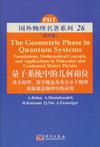量子系统中的几何相位
出版时间:2009-3 出版社:科学出版社 作者:博赫姆 页数:439
Tag标签:无
前言
对于国内的物理学工作者和青年学生来讲,研读国外优秀的物理学著作是系统掌握物理学知识的一个重要手段。但是,在国内并不能及时、方便地买到国外的图书,且国外图书不菲的价格往往令国内的读者却步,因此,把国外的优秀物理原著引进到国内,让国内的读者能够方便地以较低的价格购买是一项意义深远的工作,将有助于国内物理学工作者和青年学生掌握国际物理学的前沿知识,进而推动我国物理学科研和教学的发展。 为了满足国内读者对国外优秀物理学著作的需求,科学出版社启动了引进国外优秀著作的工作,出版社的这一举措得到了国内物理学界的积极响应和支持,很快成立了专家委员会,开展了选题的推荐和筛选工作,在出版社初选的书单基础上确定了第一批引进的项目,这些图书几乎涉及了近代物理学的所有领域,既有阐述学科基本理论的经典名著,也有反映某一学科专题前沿的专著。在选择图书时,专家委员会遵循了以下原则:基础理论方面的图书强调“经典”,选择了那些经得起时间检验、对物理学的发展产生重要影响、现在还不“过时”的著作(如狄拉克的《量子力学原理》)。反映物理学某一领域进展的著作强调“前沿”和“热点”,根据国内物理学研究发展的实际情况,选择了能够体现相关学科最新进展,对有关方向的科研人员和研究生有重要参考价值的图书。这些图书都是最新版的,多数图书都是2000年以后出版的,还有相当一部分是当年出版的新书。因此,这套丛书具有权威性、前瞻性和应用性强的特点。由于国外出版社的要求,科学出版社对部分图书进行了少量的翻译和注释(主要是目录标题和练习题),但这并不会影响图书“原汁原味”的感觉,可能还会方便国内读者的阅读和理解。 “他山之石,可以攻玉”,希望这套丛书的出版能够为国内物理学工作者和青年学生的工作和学习提供参考,也希望国内更多专家参与到这一工作中来,推荐更多的好书。
内容概要
Aimed at graduate physics and chemistry students, this is the first comprechenslve monograph covering the concept of thegeometric phase in quantum physics from its mathematical foundations to its physical applications and experimental manifestations. It contains all the premises of the adiabatic Berry phase as well as the exact Anandan-Aharonov phase. It discusses quantum systems in a classical time-independent environment (time dependent Hamiltonians) and quantum systems in a changing environment (gauge theoryofmolecular physics). The mathematical methods used are a combination of differential geometry and the theory of Iinear operators in Hilbert Space. As a result, the monograph demonstrates how non-trivial gauge theories naturally arise and how the consequences can be experimentally observed. Readers benefit by gaining a deep understanding of the long-ignored gauge theoretic effects of quantum methanics and how to measure them.
书籍目录
1 Introduction2 Quantal Phase Factors for Adiabatic Changes 2.1 Introduction 2.2 Adiabatic Approximation 2.3 Berry's Adiabatic Phase 2.4 Topological Phases and the Aharonov-Bohm Effect Problems3 Spinning Quantum System in an External Magnetic Field 3.1 Introduction 3.2 The Parameterization of the Basis Vectors 3.3 Mead-Berry Connection and Berry Phase for Adiabatic Evolutions - Magnetic Monopole Potentials 3.4 The Exact Solution of the SchrSdinger Equation 3.5 Dynamical and Geometrical Phase Factors for Non-Adiabatic Evolution Problems4 Quantal Phases for General Cyclic Evolution 4.1 Introduction 4.2 Aharonov-Anandan Phase 4.3 Exact Cyclic Evolution for Periodic Hamiltonians Problems5 Fiber Bundles and Gauge Theories 5.1 Introduction 5.2 From Quantal Phases to Fiber Bundles 5.3 An Elementary Introduction to Fiber Bundles 5.4 Geometry of Principal Bundles and the Concept of Holonomy 5.5 Gauge Theories 5.6 Mathematical Foundations of Gauge Theories and Geometry of Vector Bundles Problems6 Mathematical Structure of the Geometric Phase I: The Abelian Phase 6.1 Introduction 6.2 Holonomy Interpretations of the Geometric Phase 6.3 Classification of U(1) Principal Bundles and the Relation Between the Berry-Simon and Aharonov-Anandan Interpretations of the Adiabatic Phase 6.4 Holonomy Interpretation of the Non-Adiabatic Phase Using a Bundle over the Parameter Space 6.5 Spinning Quantum System and Topological Aspects of the Geometric Phase Problems7 Mathematical Structure of the Geometric Phase II: The Non-Abelian Phase 7.1 Introduction 7.2 The Non-Abelian Adiabatic Phase 7.3 The Non-Abelian Geometric Phase 7.4 Holonomy Interpretations of the Non-Abelian Phase 7.5 Classification of U(N) Principal Bundles and the Relation Between the Berry-Simon and Aharonov-Anandan Interpretations of Non-Abelian Phase Problems8 A Quantum Physical System in a Quantum Environment - The Gauge Theory of Molecular Physics 8.1 Introduction 8.2 The Hamiltonian of Molecular Systems 8.3 The Born-Oppenheimer Method 8.4 The Gauge Theory of Molecular Physics 8.5 The Electronic States of Diatomic Molecule 8.6 The Monopole of the Diatomic Molecule Problems9 Crossing of Potential Energy Surfaces and the Molecular Aharonov-Bohm Effect 9.1 Introduction 9.2 Crossing of Potential Energy Surfaces 9.3 Conical Intersections and Sign-Change of Wave Functions 9.4 Conical Intersections in Jahn-Teller Systems 9.5 Symmetry Of the Ground State in Jahn-Teller Systems 9.6 Geometric Phase in Two Kramers Doublet Systems 9.7 Adiabatic-Diabatic Transformation10 Experimental Detection of Geometric Phases I:Quantum Systems in Classical Environments11 Experimental Detection of Geomentric PhasesII: Quantum Systems in Quantum Environments12 Geometric Phase in Condensed Matter I: Bloch Bands 13 Geometric Phase in Condensed Matter II: The Quantum Hall Effect14 Geometric Phase in Condensed Matter III: many-Body SystemsA. An Elementary Introduction to Manifolds and Lie GroupsReferencesIndex
章节摘录
6.1 Introduction In the preceding chapter, we have developed the parts of the theory of fiber bundles which are relevant to our study of geometric phases and briefly described gauge theories. We introduced abstract gauge theories as generalizations of the Abelian gauge theory of electromagnetism. There is also another Abelian gauge theory which we encountered in Chap. 4. We call the latter the Abelian gauge theory of quantum mechanics. The parameter space of this gauge theory is the projective Hilbert space P(H) associated with a Hilbert space H, the matter fields are the pure state vectors which belong to H, the gauge or symmetry group is the group U(1) of the phases of the state vectors,and the gauge potential is the Aharonov-Anandan (A-A) connection. The defining PFB associated with this gauge theory is the A-A bundle n whose structure is determined by the Hilbert space H. The A-A connection defines a natural geometric structure on n. The associated vector bundle to that yields the state vectors as its global sections is the one defined by the standard representation of U(1). Thus it is a complex line bundle over 9(H). In this chapter, we shall present a detailed description of the mathematical structure of the Abelian gauge theory of quantum mechanics. In particular we offer different holonomy interpretations of the Abelian geometric phase and reveal their relationship. 6.2 Holonomy Interpretations of the Geometric Phase In Chap. 4, we outlined a holonomy interpretation of the geometric phase."This interpretation used the U(1) PFB n (4.33) and identified the phase with the holonomy of a particular connection which we called the AharonovAnandan (A-A) connection. We shall devote this section to a more systematic discussion of the holonomy interpretations of the geometric phase. We shall start our analysis by first describing an alternative interpretation of the adiabatic phase.
图书封面
图书标签Tags
无
评论、评分、阅读与下载
用户评论 (总计4条)
- 这本书是由几个作者合作写的。在如何用微分几何的语言来描述量子力学体系(薛定额方程决定)上非常清晰。现代微分几何在物理上的书多是在规范场上的运用,近20多年来在凝聚态物理中的运用,基础理论的书却很少,这本书非常难得。该书从BEERYPHASE开始,到GAUGEFIELDS,都有很深的几何直觉。最后面3章对凝聚态物理中新的研究热点——拓扑相(TOPOLOGICALPHASE)提供了很好的基础知识。现在理论物理学前沿研究中,除了弦论(STRINGTHEORY),强关联系统的研究算是最难的领域了,中国人一般都偏好其中”干净“的研究(相对于俄国人喜欢”DIRTY"PHYSICS),这本书作者之一Q.NIU的深厚的数学物理基础和几何直觉就非常值得学习。书中有部分章节关于分子动力学方面,对于理论物理研究的兴趣不大,就直接跳过,不影响全书的连续性。作为物理化学交叉学科,不熟悉,不作评价。
- 对有志于搞理论的人值得看看
- 对整体性感兴趣的同仁可以看看,嘿嘿!
- 这本书在这个系列还可以,还有一页勘误表,虽然是一如既往的贵的离谱,不愧是传承科学出版社的优良传统了。
相关图书
- 中国旅游资源概论
- 现代成本会计学 1995
- 中国含油气盆地构造类型
- 高师音乐舞蹈教学论
- 文献 中外名画邮票珍品 上中下
- 交流与合作
- 99国际物理教师学术交流论文集 2000
- 中国法律思想史简编上
- 现代企业管理统计学原理 1996
- 当今世界的民族关系与民族问题 1995
- 社会主义新论 2000
- 桂林 人间仙境-桂林山水摄影精品集 2000
- 桂林风光摄影集
- 古代咏物诗精选点评
- 毛泽东编辑思想与实践
- 兰台拾珍
- 艾滋病基础与临床
- 油田化学剂
- 渤海湾浅海油气田开发工程技术文集
- 科技评价论
- 石油工业技术监督工作五十年
- 高等学校英语应用能力考试综合练习
- 桂林抗战文化研究文集
- 中國歴史中的技術與科學
- 育种原理与方法 1995
